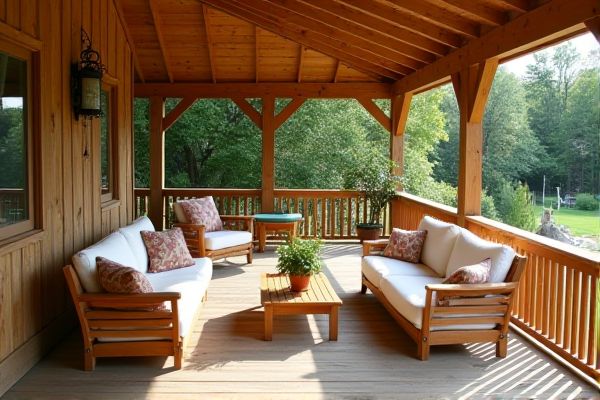
Polywood offers a low-maintenance, weather-resistant alternative to teak, mimicking the classic wood look without the need for sealing or oiling, while teak remains valued for its natural durability and rich, warm tones that age beautifully over time. Discover which material best suits your porch furniture needs by exploring the detailed comparison in the rest of this article.
Table of Comparison
| Feature | Polywood | Teak |
|---|---|---|
| Material Type | Recycled high-density polyethylene (HDPE) lumber | Natural hardwood from the Teak tree (Tectona grandis) |
| Durability | Highly resistant to weather, rot, insects, and moisture | Extremely durable, naturally resistant to rot, insects, and weather |
| Maintenance | Minimal; requires occasional cleaning with soap and water | Requires periodic oiling and cleaning to maintain appearance |
| Appearance | Available in various colors, mimics painted wood | Classic warm golden-brown natural wood grain |
| Price Range | Moderate to high, often more affordable than teak | High; considered a premium hardwood |
| Environmental Impact | Eco-friendly, made from recycled plastics | Harvesting impacts forests unless sourced sustainably |
| Weight | Heavier due to density of recycled plastic | Lighter than polywood, dense but easier to move |
| Resistance to Fading | Highly fade-resistant from UV-stabilized additives | Fades naturally over time, develops a silver patina |
Introduction to Polywood and Teak Porch Furniture
Polywood porch furniture is made from recycled plastic lumber, offering exceptional durability, resistance to weather, and low maintenance, making it ideal for outdoor use. Teak porch furniture is crafted from high-quality hardwood known for its natural oils that protect against moisture, insects, and decay while developing a beautiful patina over time. Choosing between Polywood and teak depends on whether you prioritize eco-friendly, maintenance-free materials or natural wood aesthetics and long-term aging qualities for your porch.
Material Composition: Polywood vs Teak
Polywood furniture is crafted from high-density polyethylene (HDPE) recycled plastic, making it resistant to moisture, insects, and fading, ideal for long-lasting porch use. Teak, a natural hardwood, contains natural oils and rubber that provide exceptional durability and weather resistance but requires regular maintenance to prevent cracking or discoloration. Your choice between Polywood and teak hinges on whether you prioritize low-maintenance synthetic materials or the classic beauty and natural resilience of hardwood.
Durability and Weather Resistance
Polywood porch furniture offers exceptional durability and superior weather resistance due to its high-density polyethylene composition, which resists moisture, fading, and cracking in extreme conditions. Teak wood is naturally strong and contains natural oils that provide excellent resistance to rot, insects, and water damage, making it a durable choice for outdoor furniture. Over time, Polywood requires less maintenance to preserve its appearance, while teak may develop a silver patina and need periodic oiling to maintain its weather-resistant properties.
Maintenance Requirements
Polywood porch furniture requires minimal maintenance, needing only occasional cleaning with soap and water to resist fading, cracking, and peeling. Teak furniture demands more upkeep, including regular cleaning and periodic application of teak oil or sealant to maintain its natural oils and prevent discoloration. The weather-resistant properties of Polywood make it ideal for those seeking low-maintenance outdoor furniture compared to the higher care needs of teak.
Aesthetic Appeal and Style Options
Polywood porch furniture offers a modern, versatile aesthetic with a wide range of color options and finishes that mimic the look of painted wood, allowing you to customize your outdoor space effortlessly. Teak furniture exudes natural elegance through its rich, warm tones and smooth grain patterns, which develop a unique patina over time, enhancing its classic appeal. Your choice between Polywood and teak depends on whether you prefer contemporary styling with low maintenance or timeless beauty with natural aging characteristics.
Environmental Impact and Sustainability
Polywood porch furniture is made from recycled plastic materials, significantly reducing waste and deforestation, making it an eco-friendly choice. Teak wood furniture, while durable and biodegradable, often comes from tropical forests where unsustainable logging practices can lead to habitat loss and reduced biodiversity. Choosing Polywood supports circular economy principles and lowers carbon footprint compared to traditional teak harvesting.
Comfort and Practicality
Polywood porch furniture offers superior comfort with its smooth, ergonomic design and resistance to heat, making it pleasant to sit on even in direct sunlight. Teak furniture provides natural warmth and durability, developing a soft, supple feel over time that enhances comfort but requires regular maintenance to prevent weathering. Your choice depends on whether you prioritize low-maintenance practicality with Polywood or the timeless, natural comfort of teak.
Cost Comparison: Upfront and Long-term
Polywood porch furniture typically demands a higher upfront investment compared to teak, but it offers superior resistance to weather, reducing maintenance costs over time. Teak's natural oils provide durability and a timeless aesthetic, though it may require periodic sealing and more frequent upkeep, impacting long-term expenses. Choosing Polywood can lower your overall cost of ownership despite the initial price difference, thanks to its longevity and minimal maintenance needs.
User Reviews and Performance
Polywood porch furniture consistently receives high praise for its low maintenance, weather resistance, and durability, making it ideal for humid and rainy climates. Teak furniture is valued for its natural beauty and strength, but users frequently mention the need for regular oiling and protection to prevent weathering and discoloration. Performance-wise, Polywood maintains color and structural integrity longer under harsh conditions, while teak offers a classic aesthetic with moderate upkeep.
Which Is Right for Your Porch?
Polywood porch furniture offers exceptional durability and low maintenance, resisting weather, fading, and insects, making it ideal for your porch if you seek long-lasting, hassle-free seating. Teak furniture provides natural beauty and a classic look with strong resistance to moisture and decay, perfect if you prefer a timeless, authentic wood aesthetic. Choosing between Polywood and teak depends on whether you prioritize maintenance-free durability or natural elegance for your porch setting.
 homyna.com
homyna.com